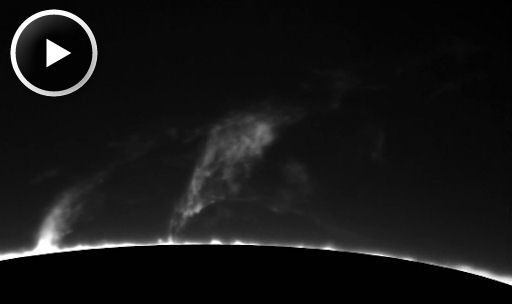CRESCENT MOON: Tonight, the crescent Moon is passing almost directly between Mars and Saturn. A good view of the western horizon is required to see the crossing. If you have one, go outside just after sunnset and take a look. Sky maps: Sept. 18, 19.
AUTUMN LIGHTS: Northern autumn is only days away, and that means aurora season is underway. For reasons researchers don't fully understand, equinoxes are the best times to see Northern Lights--especially around the Arctic Circle. Aurora tour guide Chad Blakley photographed this first sign of autumn from Abisko National Park on Sweden on Sept 14th:
"The auroras were in the sky as soon as the sun went down, and they continued to glow well into the morning," says Blakley. "It was another great night in Abisko."
More autumn lights are in the offing as three solar wind streams are expected to buffet Earth's magnetic field, one after another, between Sept. 18th and 22nd. The long-range forecast includes a 15% chance of severe geomagnetic storms around the Artic Circle. Aurora alerts: text, voice.
PLASMA RAIN: The sun hasn't been flaring much lately, but there's more to solar activity than flares. For instance, on Saturday amateur astronomer Michael Buxton of Ocean Beach, CA, witnessed a dynamic episode of "plasma rain" on the sun's western limb. Click on the arrow to set the shower in motion:
The movie, which Buxton assembled from a series of 1 minute exposures taken over a 2 hour period on Sept. 15th, shows Moon-sized "droplets" of plasma swirling and falling along magnetic field lines from the sun's atmosphere to the sun's surface. That's how it rains on the sun.
This storm cloud, aka "prominence", has since rained out. The western limb is clear and sunny again.

![]()
Solar wind
speed: 365.4 km/sec
density: 5.7 protons/cm3
explanation | more data
Updated: Today at 1456 UT
![]()
X-ray Solar Flares
6-hr max: C1 1009 UT Sep18
24-hr: C1 1009 UT Sep18
explanation | more data
Updated: Today at: 1459 UT
![]()
![]()
![]()
Daily Sun: 18 Sep 12
![]()
![]()
A new sunspot (circled) emerging over the sun's NE limb increases the chances of flares in the days ahead. Credit: SDO/HMI
![]()
![]()
![]()
Sunspot number: 51
What is the sunspot number?
Updated 18 Sep 2012
Spotless Days
Current Stretch: 0 days
2012 total: 0 days (0%)
2011 total: 2 days (<1%)
2010 total: 51 days (14%)
2009 total: 260 days (71%)
Since 2004: 821 days
Typical Solar Min: 486 days
Update 18 Sep 2012
The Radio Sun
10.7 cm flux: 102 sfu
explanation | more data
Updated 18 Sep 2012
![]()
![]()
![]()
Current Auroral Oval:
![]()
Switch to: Europe, USA, New Zealand, Antarctica
Credit: NOAA/POES
![]()
![]()
![]()
Planetary K-index
Now: Kp= 2 quiet
24-hr max: Kp= 3 quiet
explanation | more data
![]()
Interplanetary Mag. Field
Btotal: 7.5 nT
Bz: 4 nT south
explanation | more data
Updated: Today at 1457 UT
![]()
![]()
![]()
Coronal Holes: 17 Sep 12
![]()
![]()
Solar wind flowing from these three coronal holes will buffet Earth's magnetic field, one after another, from Sept. 18th through Sept. 22nd. Credit: SDO/AIA.






